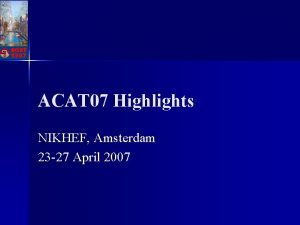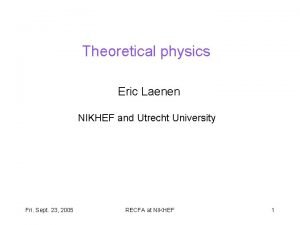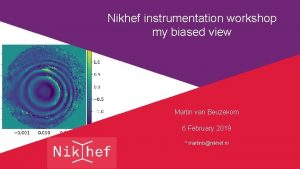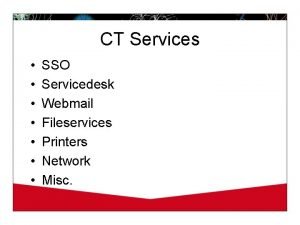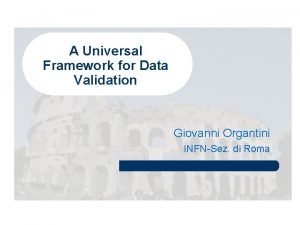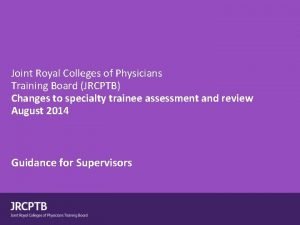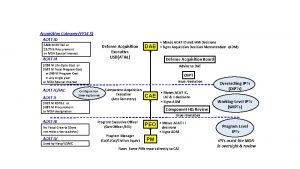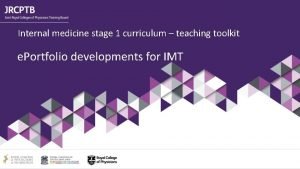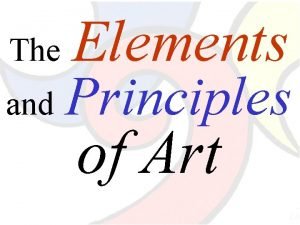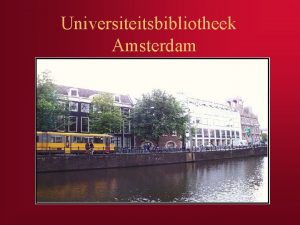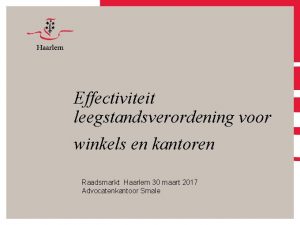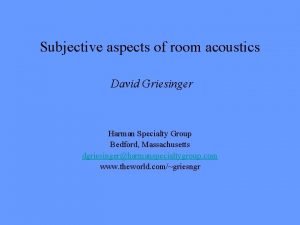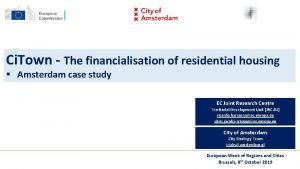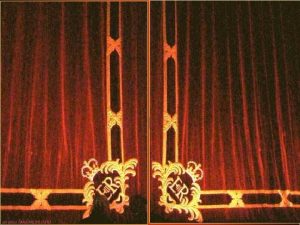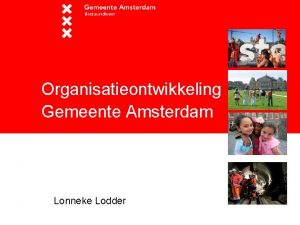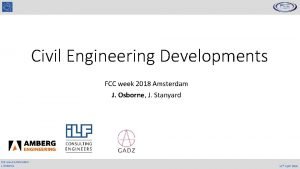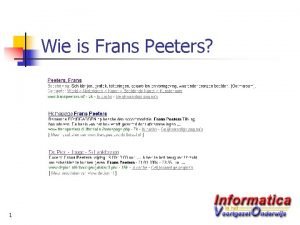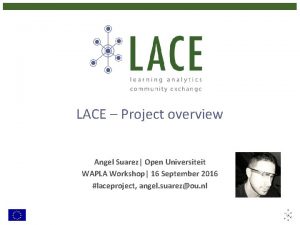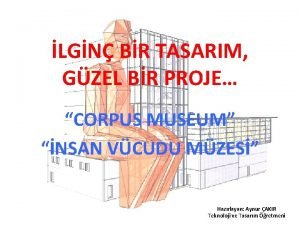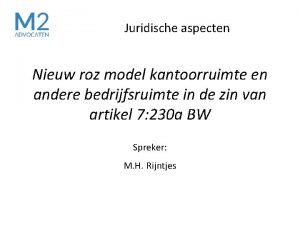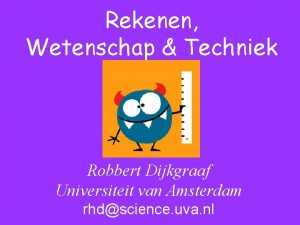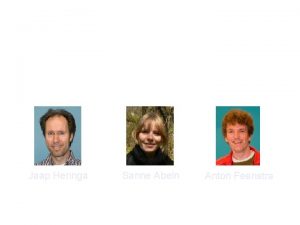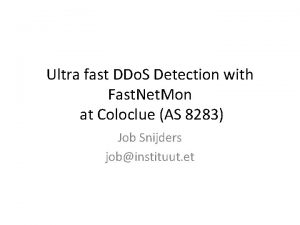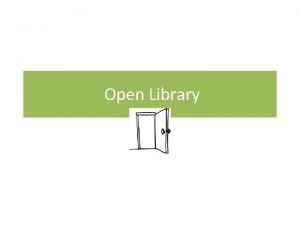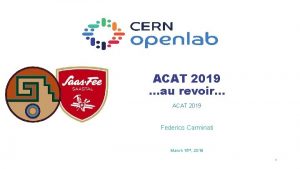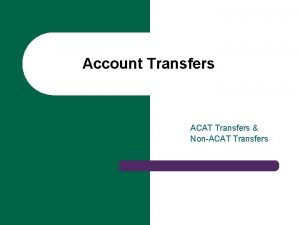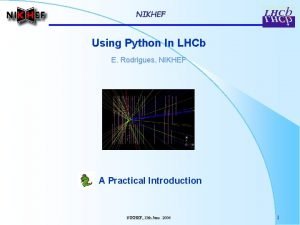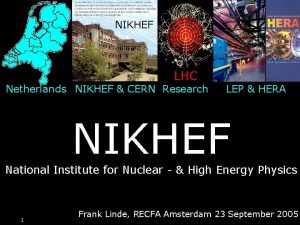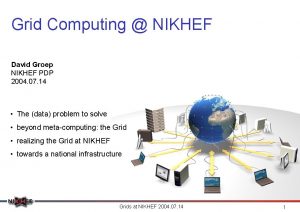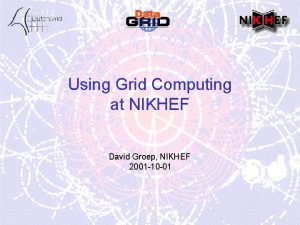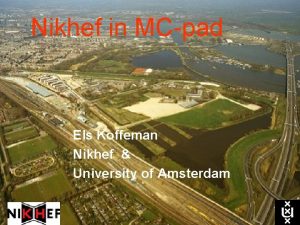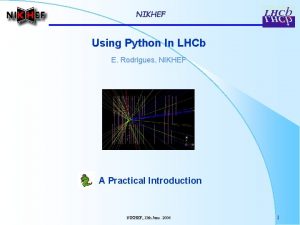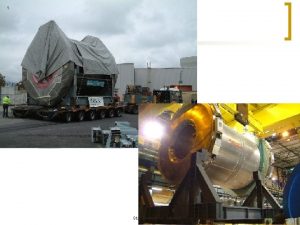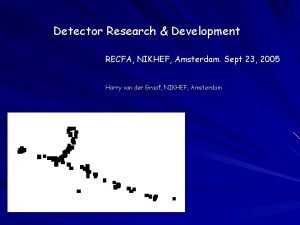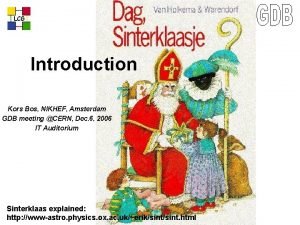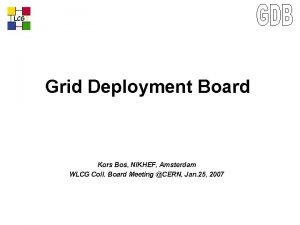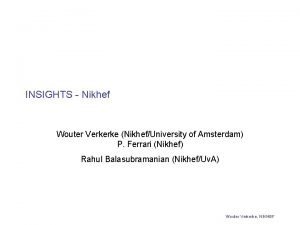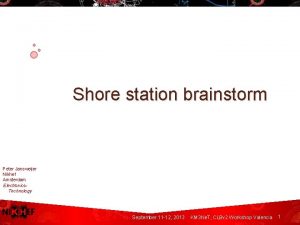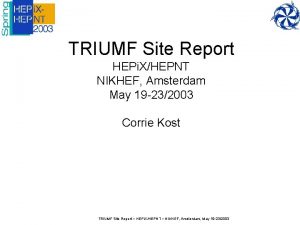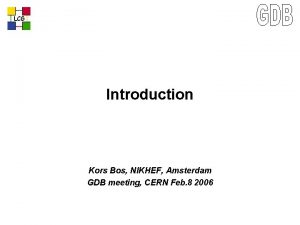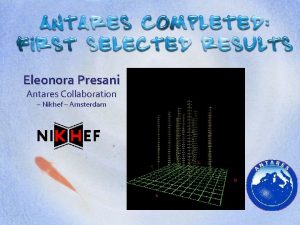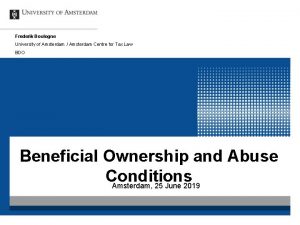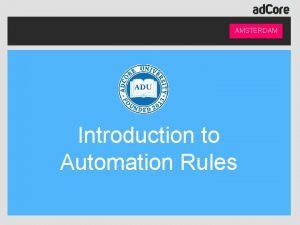ACAT 07 Highlights NIKHEF Amsterdam 23 27 April














































- Slides: 46

ACAT 07 Highlights NIKHEF, Amsterdam 23 -27 April 2007

The Workshop For more information http: //agenda. nikhef. nl/conference. Display. py? conf. Id=55 n n Plenary talks - 9 Parallel sessions - 3 Computer Technology for Physics Research (24 talks) Data Analysis – Algorithms and Tools (28 talks) Methodology of Computations in Theoretical Physics (28 talks) n n n Round-table discussions Plenary panel discussion Summary talks 114 worldwide participants

Plenary Talks n Jos Engelen (CERN): Exploration of the Terascale Challenges n Markus Schulz (CERN): Bootstrapping a Grid Infrastructure (advise by Jeff Templon)

Plenary talk by Ronald van Driel Providing HPC Resources for Philips Research and Partners

To What Extent Can We Rely on the Results of Scientific Computations Plenary talk by Les Hatton For more information and papers see http: //www. leshatton. org/

Plenary talk by Jeff Templon Grids : Interaction and Scaling (Analysis on the Grid)

Panel Disscusion: Critical Issues of Distributed Computing n n Bruce Allen: Einstein@Home and BOINC Fons: Interactive Parallel Distributed Data Analysis Using PROOF

Session 1: Computing Technology for Physics Research n 7 sessions 24 talks – – – 12 Grid 5 Monitoring/online 3 Math packages 2 GUIs 1 PROOF 1 Simulation

Grid

Middleware Grid • All experiments make large usage of existing MW… but all have developed private solutions to complement it

Grid Ganga

Grid Ali. En

Grid CMS – Crab

Grid Virtualization

Grid Storage - d. Cache

Grid Castor-2 Fabric Storage

Data Placement • Grid • Ideally. . . • • Data is produced and placed randomly Data replication or job placement at data location are optimised by the Grid In reality • • Data is placed in a given location Jobs are sent to this location

Grid Analysis


Grid Analysis & Simulation of the Grid Itself?

Online Monitoring

Online Monitoring CMS RCMS

Online Monitoring ATLAS Muon Calibration

Online Monitoring DZero

Online Monitoring CDF Experiment Detector at Fnal) (Compact

Simulation

ROOT

Summary of Session 2 n Session on Data Analysis, Algorithms and Tools : – Neural Networks and Other Pattern Recognition Techniques – Evolutionary Algorithms – Advanced Data Analysis Environments – Statistical Methods – Detector and Accelerator Simulations – Reconstruction Algorithms – Visualization Techniques

Multi-Variate Analysis Methods n Large fraction of the talks on MVA: – General purpose implementation (e. g. TMVA, SPR) – New methods (self-organizing maps (SOM) ) – Varied usage: n n n Running experiments (Tevatron) New experiments (LHC, BESIII) Cosmic Ray experiments Trigger Reconstruction (Track, vertex, e/γ, b-, τ-tagging) Data analysis, event selection 29

Multi. Variate Methods Usage 30

Discussion on Usage of Multivariate Methods P. Bhat: Multivariate Methods in HEP • Sociological Issues ãWe have been conservative in the use of MV methods for discovery ãWe have been more aggressive in the use of MV methods for setting limits ãBut discovery is more important and needs all the power you can muster! ãThis is expected to change at LHC (? ) • Multivariate Analysis Issues ãDimensionality ãChoosing the right method for the problem ãControlling ãTesting Reduction: optimal choice of variables without losing information Model Complexity Convergence ãValidation ãComputational ãCorrectness Efficiency of modeling ãWorries about hidden bias ãWorries about underestimating errors Thomas Speer

Multi. Variate Packages n Implemented multi-purpose MVA packages – TMVA (available in ROOT and in Sourcefourge) n presented by K. Voss – Stat. Pattern. Recognition (available in Sourceforge) n n by I. Narsky (presented by A. Buckley) Provide common platform & interface for all classifiers – training, testing and evaluation of the MVAs – easy and convenient for users n n can choose their preferred methods Provide some identical methods or very similar – need to compare the implementations – have standard benchmarks (with reference data-sets) 32

TMVA (H. Voss) n algorithms currently in TMVA: – – – – Rectangular cut optimisation Projective and Multi-dimensional likelihood estimator Fisher discriminant and H-Matrix (2 estimator) Artificial Neural Network (3 different implementations) Boosted/bagged Decision Trees Rule Fitting Support Vector Machines 33

Stat. Pattern. Recognition (A. Buckley for I. Narsky) n Large choice of implemented Classifiers: – – – – Decision split, or stump Decision trees (2 flavors: regular tree and top-down tree) Bump hunter (PRIM, Friedman & Fisher) with different FOM LDA (aka Fisher) and QDA Logistic regression Boosting: discrete Ada. Boost, real Ada. Boost, and epsilon-Boost. Arc-x 4 (a variant of boosting from Breiman) Bagging. Can bag any sequence of classifiers. Random forest Backprop NN with a logistic activation function (original implementation) Multi-class learner (Allwein, Schapire and Singer) Interfaces to SNNS neural nets (without training): 34 Backprop neural net, and Radial Basis Function

Stat. Pattern. Recognition

Various Usage of MVA n Presentations showing usage of MVA: – P. Bhat: Usage in HEP (at the Tevatron) n Baysian NN – A. Heikkinen: Separation of Higgs boson with SOM – M. Wolter: Optimization of tau identification in ATLAS n comparison of TMVA algorithms – R. C. Torres: Online electron/jet-identification in ATLAS using NN – J. Seixas: Online electron/jet-identification in ATLAS using SOM – S. Riggi: NN for high energy cosmic rays mass identification – S. Khatchadourian: NN Level 2 Trigger in Gamma Ray Astronomy

Baysian Neural Networks 37

Self-Organizing Maps (SOM) (A. Heikkinen) A. Heikkinen: Separation of Higgs boson with SOM • • Self-organising maps (SOM): mapping from n-dimensional input data space onto a regular two-dimensional array of neurons: ã Every neuron of the map is associated with an n-dimensional reference vector ã The neurons of the map are connected to adjacent neurons by a neighborhood relation, which dictates the topology of the map ã Similar input patterns are mapped to adjacent regions of the characteristics map. ã Unsupervised training phase: the SOM forms an elastic net that folds onto the ”cloud” formed by input data and approximates the density of the data Use SOM for b-tagging at CMS: ã pp →bb. H ã Track-based IP tag ã Can accommodate missing date ã Tagging efficiency 73 %, 11 % mistagging SUSY , H SUSY → ττ

Evolutionary Algorithms • Natural evolution: generate a population of individuals with increasing fitness to environment • Evolutionary ãProcess ãAbility computation simulates the natural evolution on a computer leading to maintenance or increase of a population to survive and reproduce in a specific environment ãQuantitatively measured by evolutionary fitness • Goal of evolutionary computation: to generate a set of solutions (to a problem) of increasing quality ãGenetic Algorithms (GA) (J. H. Holland, 1975): A. Drozdetskiy - GARCON ãGenetic Programming (GP) (J. R. Koza, 1992) ãGene Expression Programming (GEP) (C. Ferreira, 2001): L. Teodorescu • Main differences: ãEncoding method ãReproduction Thomas Speer method

Genetic Algorithm A. Drozdetskiy: GARCON

Session 3 n Methodology of Computations in Theoretical Physics – Loop technology n FORM and parallel version (Par. Form) – Generators and Automators (automatic computation systems) n n from physics processes to event generators advances in algorithms and systems – optimize FFT with max in-cache operations (J. Raynolds) – Error-free algorithms to solve systems of linear equations (M. Morhac)

Statistical Algorithms n n Baysian approach for upper limits and Confidence Levels (Zhu, Bitykov) Chi 2 for comparison of weighted and unweighted histograms (N. Gagunashvili) – algorithm introduced in ROOT by D. Hertl last summer n n Machine learning approach to unfolding (N. Gagunashvili) Two dimensional goodness of fit testing (R. Lopes)

Plenary Sessions n J. Schmidhuber : Recent Progress in Machine Learning – Recurrent Neural Networks n new feedback network: – Long-Short Term Memory (LSTM) n various applications: – robotics, speed recognition, time-series prediction, etc. . . – no slides posted, see his Web-site (google Schmidhuber n or Recurrent Neural Networks) n

Plenary Sessions n J. Vink (Shell): Computing Challenges in Oil and Gas Field Simulation

Plenary sessions n L. Mullin (NSF): Grand Challenges in Computational Mathematics: Numerical, Symbolic and Algebraic Computing. An NSF View – Processing power doubles every 18 month (Moore’s law) – Compilers (SW) double every 18 years

Conclusion Proceedings on DVD with an ISBN number n It was a very nice conference n – Many interesting talks on various subjects – Useful discussions n Well organized … with a nice weather
 Non-acat
Non-acat Amsterdam 27 april
Amsterdam 27 april Eric laenen
Eric laenen Nikhef
Nikhef Nikhef webmail
Nikhef webmail Acat roma
Acat roma Jrcptb msf
Jrcptb msf Acat id
Acat id Acat imt
Acat imt Highlights from the book of isaiah
Highlights from the book of isaiah The passage highlights……
The passage highlights…… Proposal highlights
Proposal highlights Highlights from the book of isaiah
Highlights from the book of isaiah Elements and principles of art
Elements and principles of art Highlights memorandum
Highlights memorandum Investment highlights
Investment highlights Sample of reflection in work immersion
Sample of reflection in work immersion Feature highlights
Feature highlights Life in new amsterdam
Life in new amsterdam Vwtv
Vwtv Economa amsterdam
Economa amsterdam Singel 425 amsterdam
Singel 425 amsterdam Eduarte rocva
Eduarte rocva Amsterdam bildirgesi
Amsterdam bildirgesi Leegstandverordening amsterdam
Leegstandverordening amsterdam Clint harman new amsterdam
Clint harman new amsterdam Citown
Citown Amsterdam opera house
Amsterdam opera house Messiaanse gemeente amsterdam
Messiaanse gemeente amsterdam Fcc amsterdam
Fcc amsterdam Carl jung amsterdam
Carl jung amsterdam Open universiteit amsterdam
Open universiteit amsterdam Debt agency amsterdam
Debt agency amsterdam Wapla
Wapla Hollanda corpus müzesi
Hollanda corpus müzesi Roz amsterdam
Roz amsterdam Amsterdam office market
Amsterdam office market Wetenschap en techniek amsterdam
Wetenschap en techniek amsterdam Bioinformatica amsterdam
Bioinformatica amsterdam Amsterdam news circulation
Amsterdam news circulation Fast net mon
Fast net mon Studentenwoningweb
Studentenwoningweb Stayz phillip island
Stayz phillip island What's happening these days
What's happening these days Walraven van hall monumento
Walraven van hall monumento Open library amsterdam
Open library amsterdam School trip amsterdam
School trip amsterdam

